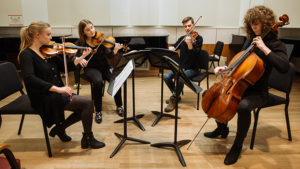Chamber music is a genre of classical music that involves a small group of instrumentalists performing together in an intimate setting, such as a small room or chamber. The term “chamber” refers to the space in which the music was originally intended to be played, which was often the private rooms of aristocrats or wealthy patrons.
What is chamber music, exactly? Unlike orchestral music, which features a large ensemble of musicians playing together, chamber music typically features just one player per part, allowing for greater individual expression and the interplay between the musicians.
Over the centuries, chamber music has become a beloved and influential genre, inspiring countless composers and performers to create some of the most beautiful and enduring works in the classical repertoire.
What is chamber music and its origins?
Chamber music is a genre of classical music that involves a small group of instrumentalists performing together in an intimate setting, such as a small room or chamber. Unlike orchestral music, which features a large ensemble of musicians playing together, chamber music typically features just one player per part, allowing for greater individual expression and the interplay between the musicians.
The origins of chamber music can be traced back to the Baroque period in the seventeenth and early eighteenth centuries when composers such as Johann Sebastian Bach and George Frideric Handel wrote chamber music for small groups of musicians to perform in the courts and homes of wealthy patrons.
However, it was during the Classical and Romantic periods in the late eighteenth and early nineteenth centuries that chamber music reached its zenith, with composers such as Wolfgang Amadeus Mozart, Ludwig van Beethoven, and Franz Schubert creating some of the most beautiful and enduring works in the genre.
Today, chamber music remains a beloved and influential genre, inspiring countless composers and performers to continue exploring its possibilities and pushing the boundaries of what is possible in this intimate and expressive form of musical expression.
Characteristics of chamber music
Chamber music is a form of classical music that is performed by a small group of instrumentalists, typically between two and nine players. Here are some characteristics of chamber music:
- Intimacy: Chamber music is designed to be performed in a small, intimate setting, such as a salon, chamber, or small concert hall. The small number of players allows for more personal and direct communication between the performers and the audience.
- Interplay: Chamber music requires a high degree of communication and cooperation between the players. Each musician is responsible for creating their own part and working together with the other players to create a cohesive musical whole.
- Flexibility: Chamber music is often performed without a conductor, which requires the players to be highly skilled in their respective instruments and able to adapt to each other’s playing styles and interpretations.
- Repertoire: The repertoire of chamber music spans several centuries, from the Baroque era to the present day. It includes a wide variety of musical genres, such as string quartets, piano trios, wind ensembles, and mixed ensembles.
- Complexity: Although chamber music is performed by a small group of players, it often requires a high level of technical skill and musical sophistication. The intricate interplay between the instruments can create complex textures and harmonies that challenge both the performers and the listeners.
Overall, chamber music is a highly refined and sophisticated art form that requires a deep understanding of musical theory, technical skill, and artistic expression.
Types of instruments typically used in chamber music
Chamber music can be performed by a variety of instrumental combinations, but there are some instruments that are more commonly used than others.
Here are some of the most common types of instruments used in chamber music:
- String instruments: String instruments are perhaps the most common in chamber music, and include the violin, viola, cello, and double bass. String quartets are one of the most popular forms of chamber music.
- Piano: The piano is a versatile instrument that is often used in chamber music, either as a solo instrument or as part of an ensemble such as a piano trio or piano quintet.
- Woodwind instruments: Woodwind instruments such as the flute, clarinet, oboe, and bassoon are also commonly used in chamber music. Wind ensembles and mixed ensembles that include both wind and string instruments are popular in chamber music.
- Brass instruments: Although less common than string and wind instruments, brass instruments such as the trumpet, horn, and trombone are sometimes used in chamber music. Brass ensembles and mixed ensembles that include both brass and string instruments are also possible.
- Percussion instruments: Percussion instruments such as the timpani, snare drum, and cymbals are used in some types of chamber music, but they are less common than the other types of instruments mentioned above.
Overall, the types of instruments used in chamber music can vary greatly depending on the musical style and the preferences of the performers. The small size of chamber ensembles allows for a wide variety of instrumental combinations and a high degree of flexibility in terms of repertoire and performance style.
Differences between chamber music and orchestral music
Chamber music and orchestral music are both important genres in classical music, but they have several key differences:
- Size of the ensemble: The most obvious difference between chamber music and orchestral music is the size of the ensemble. Chamber music is typically performed by a small group of musicians, ranging from a duo to a small ensemble of nine players, while orchestral music is performed by a large ensemble of musicians, ranging from 30 to over 100 players.
- The complexity of the music: Chamber music tends to be more intricate and complex than orchestral music, as the smaller ensemble allows for more subtle and nuanced musical interactions between the players. Orchestral music, on the other hand, is designed to showcase the full range and power of a large ensemble, with more emphasis on grandeur and spectacle.
- Role of the conductor: In orchestral music, a conductor is typically needed to lead a large ensemble and keep everyone together. In chamber music, however, the musicians usually play without a conductor, relying instead on their own communication and musical instincts to stay in sync.
- Repertoire: The repertoire of orchestral music is typically more varied and expansive than that of chamber music. Orchestras are capable of performing a wider range of musical styles and genres, from symphonies and concertos to operas and ballets. Chamber music, on the other hand, is usually performed in a more intimate and focused setting, with a narrower range of repertoire that includes string quartets, piano trios, and other small ensemble works.
- Performance setting: Orchestral music is typically performed in large concert halls, where the sound of the full ensemble can be properly amplified and heard by a large audience. Chamber music, however, is often performed in smaller venues such as salons, private homes, and small concert halls, where the more delicate and nuanced sound of the smaller ensemble can be appreciated.
Overall, while both chamber music and orchestral music are important genres in classical music, they differ in terms of ensemble size, musical complexity, the role of the conductor, repertoire, and performance setting.
Famous chamber music pieces and their composers
There are many famous chamber music pieces that have been composed throughout history. Here are some examples of notable chamber music pieces and their composers:
- String Quartets by Ludwig van Beethoven: Beethoven is widely regarded as one of the greatest composers of chamber music, and his string quartets are considered some of his greatest works. His sixteen string quartets, including the “Razumovsky” quartets and the “Late” quartets, are known for their innovation and emotional depth.
- Piano trios by Franz Schubert: Schubert’s piano trios, including the “Trout” and the “E-flat Major” trio, are some of the most beloved works in the chamber music repertoire. These pieces showcase Schubert’s gift for melody and his ability to weave together intricate musical textures.
- “The Art of Fugue” by Johann Sebastian Bach: Bach’s “The Art of Fugue” is a set of contrapuntal compositions that explore the possibilities of fugue and other forms of polyphony. The work is often performed by small ensembles and is considered a masterpiece of Baroque music.
- “Death and the Maiden” quartet by Franz Schubert: Schubert’s “Death and the Maiden” quartet is a powerful and dramatic work that is based on a song of the same name that he composed earlier in his career. The quartet is known for its dark and haunting melodies and is often regarded as one of the greatest chamber music pieces ever written.
- Piano quartets by Wolfgang Amadeus Mozart: Mozart’s piano quartets, including the “G minor” and the “E-flat Major” quartets, are among his most popular chamber music works. These pieces showcase Mozart’s gift for melody and his skill in balancing the individual parts of the ensemble.
- “La Mer” by Claude Debussy: Debussy’s “La Mer” is a symphonic work that has also been arranged for a chamber ensemble. The piece is known for its evocative depictions of the sea and is considered one of Debussy’s most important works.
Overall, these are just a few examples of the many famous chamber music pieces that have been composed throughout history. These works showcase the incredible range and variety of the chamber music genre and demonstrate the skill and artistry of some of the greatest composers of all time.
The Role of chamber music in classical music education
Chamber music plays a significant role in classical music education. It refers to music that is composed for a small group of instruments, typically two to eight musicians and is meant to be performed in an intimate setting.
One of the primary benefits of chamber music is that it allows musicians to develop their individual technical skills while also learning to work collaboratively with others. Unlike orchestral music, where a large group of musicians is playing together, chamber music requires each player to contribute significantly to the overall sound.
Also, this means that musicians must be able to listen carefully to one another and adjust their playing to ensure that the group is playing in sync.
Furthermore, playing chamber music helps musicians develop a deeper understanding of musical phrasing, timing, and dynamics. It provides opportunities to explore nuances in music that are often overlooked in larger ensembles. This attention to detail is essential in classical music, where the interpretation of a piece of music can make all the difference in performance.
Chamber music is also a great way for musicians to build confidence and experience performing in front of an audience. Since the setting is typically more intimate, musicians have the opportunity to connect with their listeners in a more personal way. They can engage with the audience and receive immediate feedback, which can help them improve their performance skills.
Overall, chamber music is an important component of classical music education. It provides a unique learning experience that allows musicians to develop their technical skills, collaborate with others, and deepen their understanding of music. Whether you are a student or a professional musician, playing chamber music is an excellent way to enhance your skills and broaden your musical horizons.
Chamber Music in contemporary music and popular culture
While chamber music has its roots in classical music, it has also found a place in contemporary music and popular culture. Many modern composers continue to create new works for chamber ensembles, incorporating elements of contemporary music and experimental techniques.
In recent years, chamber music has also become more accessible to a wider audience through collaborations with popular musicians and genres. For example, there have been numerous collaborations between classical chamber ensembles and popular musicians such as rock bands, pop singers, and hip-hop artists. These collaborations often bring together different musical traditions and create exciting new sounds.
In addition, chamber music has also found a place in film and television soundtracks, with composers using string quartets and other chamber ensembles to create emotional and dramatic music for the screen.
Furthermore, there are numerous contemporary chamber music festivals around the world, showcasing the work of both established and emerging composers. These festivals provide a platform for new works and collaborations and also attract a diverse audience interested in exploring new sounds and musical experiences.
Overall, chamber music continues to evolve and adapt to contemporary music and popular culture. It remains a vital and exciting form of music, with a rich history and a promising future.
The benefits of playing chamber music for musicians
Playing chamber music offers numerous benefits for musicians, regardless of their skill level or experience.
Some of these benefits include:
- Improved listening skills: Chamber music requires musicians to actively listen to one another and adjust their playing accordingly. This helps to develop strong listening skills, which are essential in all areas of music performance.
- Enhanced ensemble skills: Working in a small group allows musicians to develop ensemble skills such as communication, cooperation, and synchronization. These skills are essential for successful performances in any ensemble setting.
- Greater musical sensitivity: Chamber music provides opportunities for musicians to explore the nuances of a piece of music in greater detail. This can lead to a deeper understanding of musical phrasing, timing, and dynamics, as well as a greater sensitivity to musical expression.
- Increased confidence: Playing chamber music in front of an audience can help to build confidence and performance skills. The intimate setting of chamber music performances can also help to reduce performance anxiety and create a more relaxed and supportive environment.
- Exposure to a wider range of music: Chamber music repertoire spans many different time periods and musical styles, providing musicians with exposure to a wide range of music. This can help to broaden their musical horizons and deepen their understanding of music history and theory.
- Opportunities for collaboration and networking: Chamber music provides opportunities for musicians to collaborate with other musicians and build professional relationships. This can lead to future performance opportunities and networking within the music industry.
Overall, playing chamber music offers numerous benefits for musicians, including improved listening and ensemble skills, increased musical sensitivity and confidence, exposure to a wider range of music, and opportunities for collaboration and networking.
Tips for listening to and appreciating chamber music
Listening to chamber music can be a rich and rewarding experience, but it can also be challenging for those who are not familiar with the genre.
Here are some tips for listening to and appreciating chamber music:
- Listen actively: Chamber music requires active listening, so it’s important to give it your full attention. Focus on the interplay between the instruments, the balance of sound, and the overall mood and atmosphere of the piece.
- Familiarize yourself with the repertoire: Chamber music encompasses a wide range of repertoire, from Baroque sonatas to contemporary works. Familiarizing yourself with the different styles and composers can help you appreciate the nuances of the music.
- Attend live performances: Hearing chamber music performed live can be a transformative experience. Look for local concerts or festivals featuring chamber music and try to attend a few performances each year.
- Pay attention to the details: Chamber music is often characterized by intricate musical details, such as subtle changes in dynamics or phrasing. Pay attention to these details and try to appreciate how they contribute to the overall effect of the piece.
- Read program notes: Many concerts and recordings include program notes that provide background information on the music being performed. Reading these notes can help you understand the historical and cultural context of the music.
- Experiment with different recordings: Chamber music is often recorded by multiple artists and ensembles. Experiment with different recordings to find ones that resonate with you and help you appreciate the music more fully.
- Be open-minded: Finally, be open-minded when listening to chamber music. It’s a diverse and constantly evolving genre, so don’t be afraid to explore new works and styles.
Recommended:
- Earbuds make my ears itch: Reasons and solution
- What is a 2 way speaker?
- What genre is Frank Sinatra?
Conclusion
Here you will get to learn about what is chamber music. Chamber music is a genre of classical music that is performed by a small group of instrumentalists, typically one player per part. The music is often characterized by its intimacy, intricate interplay between the instruments, and complex musical structures.
Chamber music repertoire spans many different time periods and musical styles, and it continues to evolve and adapt to contemporary music and popular culture.
Playing chamber music offers numerous benefits for musicians, including improved listening and ensemble skills, increased musical sensitivity and confidence, exposure to a wider range of music, and opportunities for collaboration and networking. For listeners, chamber music can be a rich and rewarding experience that requires active listening and an open mind.




